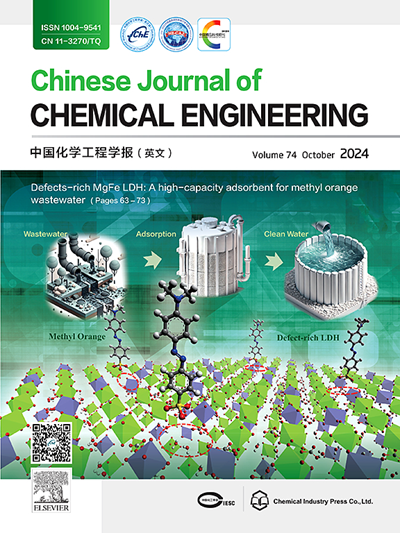可见光下磁可分离可回收MnFe2O4@SiO2@NH2纳米复合偶联酰化MWCNTS的合成及其光催化性能的增强
IF 3.7
3区 工程技术
Q2 ENGINEERING, CHEMICAL
引用次数: 0
摘要
采用简单的一步改性方法制备了MnFe2O4@SiO2@NH2与酰基化多壁碳纳米管(AMWCNTS)偶联,并将其用于可见光辅助去除环丙沙星(CIP)。利用FT-IR、XRD、VSM、拉曼光谱、FE-SEM、BJH/BET、UV-Vis和带隙分析对纳米复合材料进行表征。在去除CIP方面,纳米复合材料的性能优于AMWCNTS和MnFe2O4@SiO2@NH2纳米颗粒。在pH = 7、初始CIP浓度为25 mg·L−1、反应时间为40 min、催化剂用量为0.8 g·L−1的条件下,CIP全部被降解。工艺开始时BOD5/COD(5天生物需氧量/化学需氧量)和BOD5/TOC(5天生物需氧量/总有机碳)分别为0.22和0.71,工艺结束时达到0.755和1.21,标志着不可生物降解废水向生物降解废水的转化。清除剂研究表明,羟基自由基和空穴对CIP的降解影响最大。用大肠杆菌对最终出水的毒性进行了研究,结果表明该工艺在出水杀菌领域取得了很好的效果。平衡数据完全符合一级动力学,反应速率常数为0.109 min−1。CIP的半衰期为6.8 min,在5个循环中,CIP的去除率仍保持在9.4%。MnFe2O4@SiO2@NH2@AMWCNTS给出了从水环境中去除CIP的显著潜力。本文章由计算机程序翻译,如有差异,请以英文原文为准。

Synthesis of magnetically separable and recyclable MnFe2O4@SiO2@NH2 nanocomposite coupled-acylated MWCNTS with enhanced photocatalytic performance under visible-light irradiation
A MnFe2O4@SiO2@NH2 coupled with acylated multi-walled carbon nanotubes (AMWCNTS) was prepared using an easy one-step modification approach and applied for the visible light-assisted removal of ciprofloxacin (CIP). FT-IR, XRD, VSM, Raman spectrum, FE-SEM, BJH/BET, UV-Vis, and band gap analysis were used to characterize nanocomposites. In terms of CIP removal, the nanocomposites outperformed both AMWCNTS and MnFe2O4@SiO2@NH2 nanoparticles. At a pH of 7, an initial CIP concentration of 25 mg·L−1, a reaction time of 40 min, and a catalyst dose of 0.8 g·L−1, all of the CIP was degraded. The ratios of BOD5/COD (5-day biological oxygen demand/chemical oxygen demand) and BOD5/TOC (5-day biological oxygen demand/total organic carbon) at the beginning of the process were 0.22 and 0.71, respectively, and reached 0.755 and 1.21 at the end of the process, which signposts the conversion of non-biodegradable wastewater into biodegradable wastewater. Scavenger studies disclosed that hydroxyl radicals and holes had the greatest effect on the degradation of CIP. The toxicity of the final effluent was also investigated with E. coli bacteria, and the results showed a very good effect of the process in the field of effluent sterilization. Equilibrium data fully followed first-order kinetics, with a reaction rate constant of 0.109 min−1. Also, the half-life for the complete degradation of CIP was equal to 6.8 min. The CIP removal efficiency still remained at 9.4% in the five cycles. MnFe2O4@SiO2@NH2@AMWCNTS gave a pronounced potential for eliminating CIP from aqueous environment.
求助全文
通过发布文献求助,成功后即可免费获取论文全文。
去求助
来源期刊

Chinese Journal of Chemical Engineering
工程技术-工程:化工
CiteScore
6.60
自引率
5.30%
发文量
4309
审稿时长
31 days
期刊介绍:
The Chinese Journal of Chemical Engineering (Monthly, started in 1982) is the official journal of the Chemical Industry and Engineering Society of China and published by the Chemical Industry Press Co. Ltd. The aim of the journal is to develop the international exchange of scientific and technical information in the field of chemical engineering. It publishes original research papers that cover the major advancements and achievements in chemical engineering in China as well as some articles from overseas contributors.
The topics of journal include chemical engineering, chemical technology, biochemical engineering, energy and environmental engineering and other relevant fields. Papers are published on the basis of their relevance to theoretical research, practical application or potential uses in the industry as Research Papers, Communications, Reviews and Perspectives. Prominent domestic and overseas chemical experts and scholars have been invited to form an International Advisory Board and the Editorial Committee. It enjoys recognition among Chinese academia and industry as a reliable source of information of what is going on in chemical engineering research, both domestic and abroad.
 求助内容:
求助内容: 应助结果提醒方式:
应助结果提醒方式:


